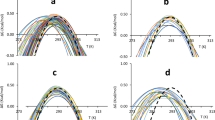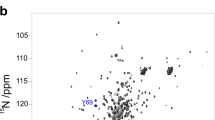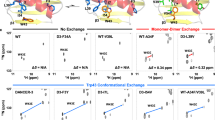Abstract
Recent developments in solution NMR methods have allowed for an unprecedented view of protein dynamics. Current insights into the nature of protein dynamics and their potential influence on protein structure, stability and function are reviewed. Particular emphasis is placed on the potential of fast side chain motion to report on the residual conformational entropy of proteins and how this entropy can enter into both the thermodynamic and kinetic aspects of protein function.
This is a preview of subscription content, access via your institution
Access options
Subscribe to this journal
Receive 12 print issues and online access
$189.00 per year
only $15.75 per issue
Buy this article
- Purchase on Springer Link
- Instant access to full article PDF
Prices may be subject to local taxes which are calculated during checkout




Similar content being viewed by others
References
Weber, G. Energetics of ligand binding to proteins. Adv. Prot. Chem. 29, 1–83 (1975).
Gurd, F.R.N. & Rothgeb, T.M. Motions in proteins. Adv. Prot. Chem. 33, 73–165 (1979).
Englander, S.W. & Kallenbach, N.R. Hydrogen exchange and structural dynamics of proteins and nucleic acids. Q. Rev. Biophys. 16, 521–655 (1983).
Frauenfelder H., Parak F., & Young RD. Conformational substates in proteins. Annu. Rev. Biophys. Biophys. Chem. 17, 451–79 (1988).
Frauenfelder, H., Sligar, S.G. & Wolynes, P.G. The energy landscapes and motions in proteins. Science 254, 1598–1603 (1991).
Onuchic, J.N., Luthey-Schulten, Z. & Wolynes, P.G. Theory of protein folding: The energy landscape perspective. Annu. Rev. Phys. Chem. 48, 545–600 (1997).
Sattler, M., Schleucher, J. & Griesinger, C. Heteronuclear multidimensional NMR experiments for the structure determination of proteins in solution employing pulsed field gradients. Prog. NMR Spectr. 34, 93–158 (1999).
McIntosh, L.P. & Dahlquist, F.W. Biosynthetic incorporation of 15N and 13C for assignment and interpretation of nuclear magnetic resonance spectra of proteins. Q. Rev. Biophys. 23, 1–38 (1990).
LeMaster, D.M. Isotope labeling in solution protein assignment and structural analysis. Progr. NMR Spectroscopy 26, 371–419 (1994).
Henry, G.D., Weiner, J.H. & Sykes, B.D. Backbone dynamics of a model membrane protein: 13C NMR spectroscopy of alanine methyl groups in detergent-solubilized M13 coat protein. Biochemistry 25, 590–598 (1985).
Nicholson, L.K. et al. Dynamics of methyl groups in proteins as studied by proton-detected 13C NMR spectroscopy. Application to the leucine residues of staphylococcal nuclease. Biochemistry 31, 5253–5263 (1992).
Muhandiram, D.R., Yamazaki, T., Sykes, B.D. & Kay, L.E. Measurement of 2H T1 and T1r relaxation times in uniformly 13C-labeled and fractionally 2H-labeled proteins in solution. J. Am. Chem. Soc. 117, 11536–11544 (1995).
LeMaster, D.M. & Kushlan, D.M. Dynamical mapping of E. coli thioredoxin via 13C NMR relaxation analysis. J. Am. Chem. Soc. 118, 9255–9264 (1996).
Wand, A.J., Bieber, R.J., Urbauer, J.L., McEvoy, R.P. & Gan, Z. Carbon relaxation in fractionally randomly 13C-enriched proteins. J. Magn. Reson. B 108, 173–175 (1995).
Rosen, M.K. et al. Selective methyl group protonation of perdeuterated proteins. J. Mol. Biol. 263, 627–636 (1996).
Lee, A.L., Urbauer, J.L. & Wand, A.J. Improved labeling strategy for 13C relaxation measurements of methyl groups in proteins. J. Biomol. NMR 9, 437–440 (1997).
Kay, L.E., Torchia, D.A. & Bax, A. Backbone dynamics of proteins as studied by 15N inverse detected heteronuclear NMR spectroscopy: application to staphylococcal nuclease. Biochemistry 28, 8972–8979 (1989).
Farrow, N.A. et al. Backbone dynamics of a free and a phosphopeptide-complexed Src homology 2 domain studied by 15N NMR relaxation Biochemistry 33, 5984–6003 (1994).
Loria, J.P., Rance, M. & Palmer, A.G., III. A relaxation compensated Carr-Purcell-Meiboom-Gill sequence for characterizing chemical exchange by NMR spectroscopy. J. Am. Chem. Soc. 121, 2331–2332 (1999).
Skrynnikov, N.R., Mulder, F.A.A., Hon, B., Dahlquist, F.W. & Kay, L.E. Probing slow timescale dynamics at methyl-containing side chains in proteins by relaxation dispersion NMR measurements: application to methionine residues in a cavity mutant of T4 lysozyme. J. Am. Chem. Soc. 123, 4556–4666 (2001).
Korzhnev, D.M., Billeter, M., Arseniev, A.S. & Orekhov, V.Y. NMR studies of Brownian tumbling and internal motions in proteins. Prog. NMR Spectr. 38, 197–266 (2001).
Lipari, G. & Szabo, A. Model-free approach to the interpretation of nuclear magnetic resonance relaxation in macromolecules. 1. Theory and range of validity. J. Am. Chem. Soc. 104, 4546–4559 (1982).
Palmer, A.G. III. Probing molecular motion by NMR. Curr. Opin. Struct. Biol. 7, 732–737 (1997).
Stone, M.F. NMR relaxation studies of the role of conformational entropy in protein stability and ligand binding. Acc. Chem. Res. 34, 379–388 (2001).
Akke, M., Brüshweiler, R. and Palmer, A.G., III. NMR order parameters and free energy: an analytical approach and its application to cooperative Ca2+ binding by calbindin D9k . J. Am. Chem. Soc. 116, 8426–8427 (1993).
Wand, A.J., Urbauer, J.L., McEvoy, R.P. & Bieber, R.J. Internal dynamics of human ubiquitin revealed by 13C-relaxation of randomly, fractionally enriched protein. Biochemistry 35, 6116–6125 (1996).
Lee, A.L., Flynn, P.F. & Wand, A.J. A comparison of 2H and 13C NMR relaxation techniques for the study of protein methyl group dynamics in solution. J. Am. Chem. Soc. 121, 2891–28902 (1999).
Lee, A.L. & Wand, A.J. Microscopic origins of entropy, heat capacity and the glass transition in proteins. Nature 411, 501–504 (2001).
Flynn, P.F., Bieber Urbauer, R.J., Zhang, H., Lee, A.L. & Wand, A.J. Main chain and side chain dynamics of a heme protein: 15N and 2H NMR relaxation studies of R. capsulatus ferrocytochrome c2 . Biochemistry 40, 6559–6569 (2001).
Liu, W. et al. Main chain and side chain dynamics of oxidized flavodoxin from C. Anabaena Biochemistry, In the press (2001).
Walsh, S.T.R., Lee, A.L., De Grado, W.F. & Wand, A.J. Dynamics of a de novo designed three-helix bundle protein studied by 15N, 13C, and 2H NMR relaxation methods. Biochemistry 40, 9650–9569 (2001).
Mittermaier, A., Kay, L.E. & Forman-Kay, J.D. Analysis of deuterium relaxation-derived methyl axis order parameters and correlation with local structure. J. Biomol. NMR 13, 181–185 (1999).
Ishima, R., Louis, J.M. & Torchia, D.A. Characterization of two hydrophobic methyl clusters in HIV-1 protease by NMR spin relaxation in. J. Mol. Biol. 305, 515–521 (2001).
Wand, A.J. On the dynamic origins of allosteric activation. Science 293, 1395 (2001).
Li, Z., Raychaudhuri, S. & Wand, A.J. Insights into the local residual entropy of proteins provided by NMR relaxation. Protein Sci. 5, 2647–2650 (1996).
Yang, D. & Kay, L.E. Contributions to conformational entropy arising from bond vector fluctuations measured from NMR-derived order parameters: application to protein folding. J. Mol. Biol. 263, 369–382 (1996).
Prompers, J.J. & Brüshweiler, R. Thermodynamic interpretation of NMR relaxation parameters in proteins in the presence of motional correlations. J. Phys. Chem. B 104, 11416–11424 (2000).
Mandel, A.M., Akke, M. & Palmer, A.G., III. Dynamics of ribonuclease H: temperature dependence of motions on multiple timescales. Biochemistry 35, 16009–16023 (1996).
Yang, D., Mittermaier, A., Mok, Y-K. & Kay, L.E. A study of protein side-chain dynamics from new 2H auto-correlation and 13C cross-correlation NMR experiments: application to the N-terminal SH3 domain from drk. J. Mol. Biol. 276, 939–954 (1998).
Wagner, G. Activation volumes for the rotational motion of interior aromatic rings in globular proteins determined by high resolution 1H NMR at variable pressure. FEBS Lett. 112, 280–284 (1980).
Pappu, R.V., Srinivasan, R. & Rose, G.D. The Flory isolated-pair hypothesis is not valid for polypeptide chains: implications for protein folding. Proc. Natl. Acad. Sci. USA 97, 12565–12570 (2000).
Lee, A.L., Kinnear, S.A. & Wand, A.J. Redistribution and loss of side-chain entropy upon formation of a calmodulin–peptide complex. Nature Struct. Biol. 7, 72–77 (2000).
Loh, A.P., Pawley, N., Nicholson, L.K. & Oswald, R.E. An increase in side chain entropy facilitates effector binding: NMR characterization of the side chain methyl group dynamics in Cdc42Hs. Biochemistry 40, 4590–4600 (2001).
Cooper, A. & Dryden, D.T.F. Allostery without conformational change. A plausible model. Eur. Biophys. J. 11, 103–109 (1984).
Freire, E. Statistical thermodynamic linkage between conformational and binding equilibria. Adv. Prot. Chem. 51, 255–279 (1998).
Pan, H., Lee, J. C. & Hilser, V.J. Binding sites in Escherichia coli dihydrofolate reductase communicate by modulating the conformational ensemble. Proc. Natl. Acad. Sci. USA 97, 12020–12025 (2000).
Pauling, L. Nature of forces between large molecules of biological interest. Nature 161, 707–709 (1948).
Jencks, W.P. (1975) Binding energy, specificity, and enzymic catalysis: the circe effect. Adv. Enzymol. 43, 219–410.
Welch, G.R., Somogyi, B. & Damjanovich, S. The role of protein fluctuations in enzyme action: A review. Prog. Biophys. Molec. Biol. 39, 109–146 (1982).
Bruice, T.C., & Benkovic, S.J. Chemical basis for enzyme catalysis. Biochemistry 39, 6267–6274 (2000).
Kohen, A., Cannio, R., Bartolucci, S. & Klinman, J.P. Enzyme dynamics and hydrogen tunneling in a thermophilic alcohol dehydrogenase. Nature 399, 496–499 (1999).
Antoniou, D. & Schwartz, S.D. Internal enzyme motions as a source of catalytic activity: rate-promoting vibrations and hydrogen tunneling. J. Phys. Chem. B 105, 5553–5558 (2001).
Balabin, I.A. & Onuchic, J.N. Dynamically controlled protein tunneling paths in photosynthetic reaction centers. Science 290, 114–118 (2000).
Malmendal, A., Evenäs, J., Forsén, S., & Akke, M. Structural dynamics in the C-terminal domain of calmodulin at low calcium levels. J. Mol. Biol. 293, 883–899 (1999).
Feher, V. A. & Cavanagh, J. Millisecond-timescale motions contribute to the function of the bacterial response regulator protein Spo0F. Nature 400, 289–293 (1999).
Volkman, B.F., Lipson, D., Wemmer, D.E., & Kern, D. Two-state allosteric behavior in a single-domain signaling protein. Science 291, 2429–2433 (2001).
Tolman, J.R., Al-Hashimi, H.M., Kay, L.E. & Prestegard, J.H. Structural and dynamic analysis of residual dipolar coupling data of proteins. J. Am. Chem. Soc. 123, 1416–1424 (2001).
Acknowledgements
I thank A. Palmer, K. Sharp and W. Englander for helpful discussion. This work was supported by grants from the NIH.
Author information
Authors and Affiliations
Rights and permissions
About this article
Cite this article
Wand, A. Dynamic activation of protein function: A view emerging from NMR spectroscopy. Nat Struct Mol Biol 8, 926–931 (2001). https://doi.org/10.1038/nsb1101-926
Received:
Accepted:
Issue Date:
DOI: https://doi.org/10.1038/nsb1101-926
This article is cited by
-
Dynamic networks observed in the nucleosome core particles couple the histone globular domains with DNA
Communications Biology (2020)
-
NMR and computational methods for molecular resolution of allosteric pathways in enzyme complexes
Biophysical Reviews (2020)
-
The role of NMR in leveraging dynamics and entropy in drug design
Journal of Biomolecular NMR (2020)
-
Transport and dispersion across wiggling nanopores
Nature Physics (2018)
-
Accurate determination of rates from non-uniformly sampled relaxation data
Journal of Biomolecular NMR (2016)



